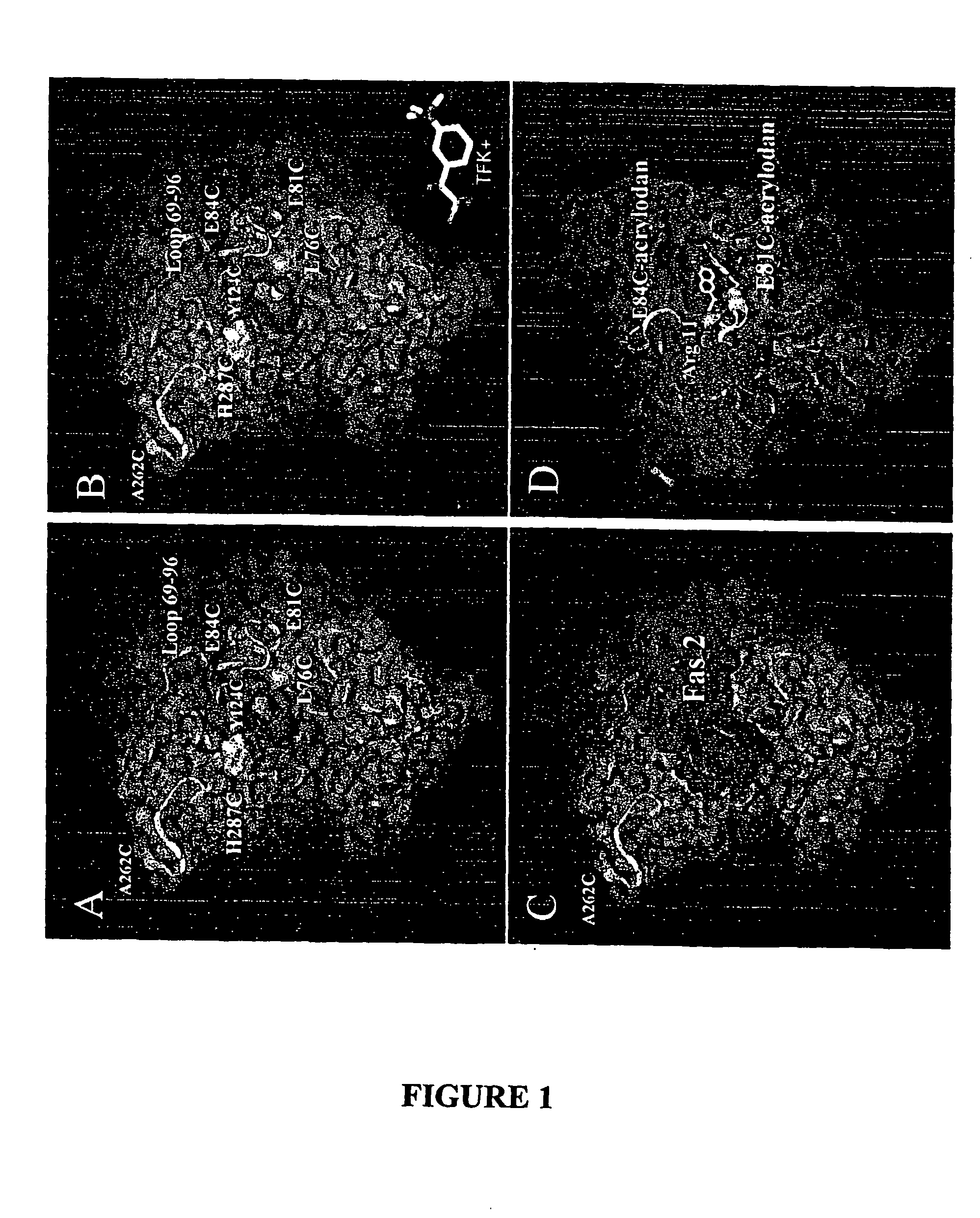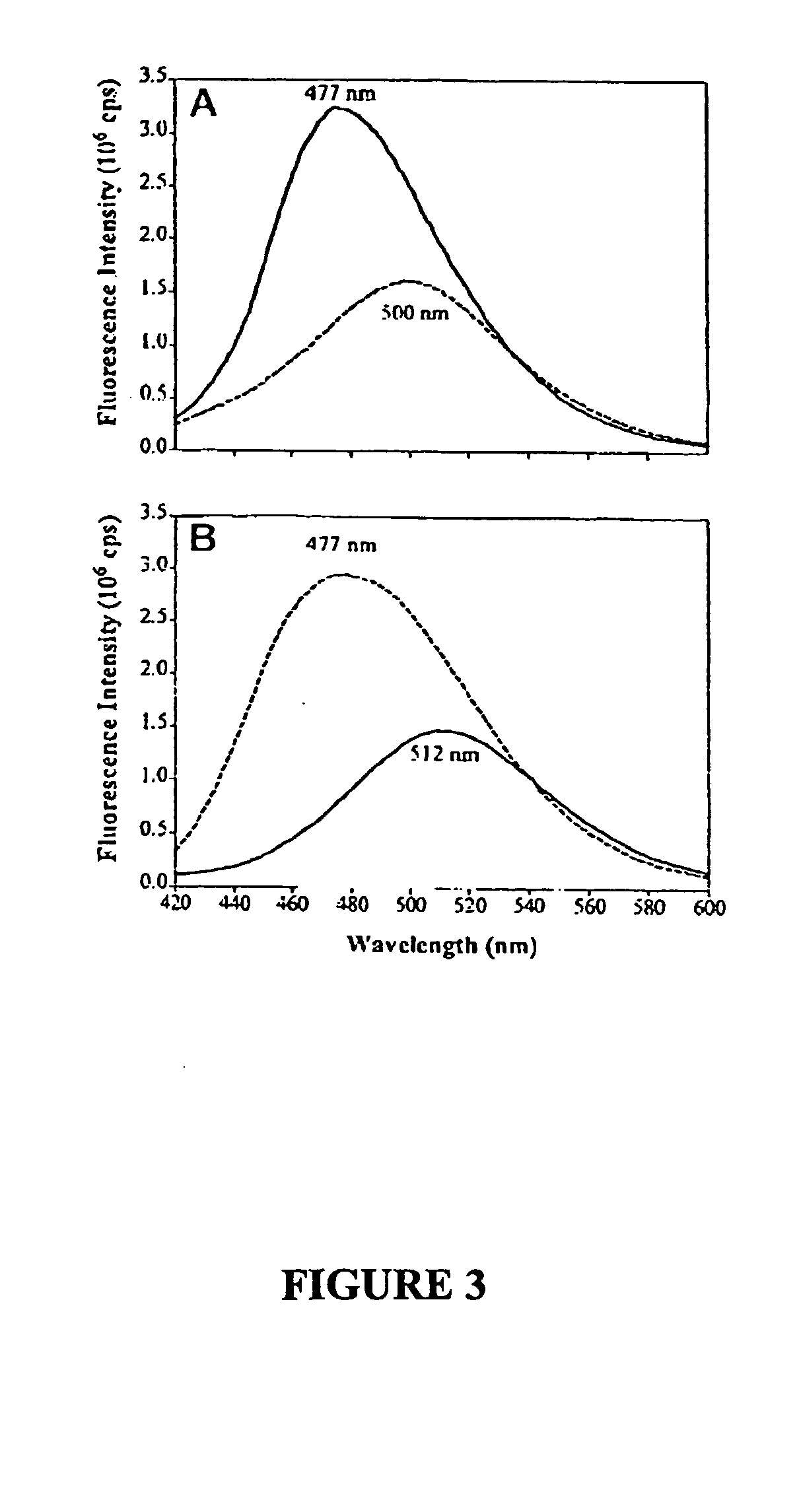Ligand sensing fluorescent acetylcholinesterase for detection of organophosphate activity
- Summary
- Abstract
- Description
- Claims
- Application Information
AI Technical Summary
Benefits of technology
Problems solved by technology
Method used
Image
Examples
example 1
Characteristics of Substrate Hydrolysis and Fasciculin 2 Inhibition
[0077] Crystallographic Structures and Solution Dynamics of the Acetylcholinesterase Complex—In the several crystal structures of AChE with conjugated or reversible bound ligands that have been studied, little evidence for change in enzyme conformation has been detected with a difference of less than a root mean square of 2 Å for the α-carbon backbone between the apoenzyme and the various complexes (4-6, 13, 14, 33-35, 44). Changes in side chain orientation occur most notably in the phenyl ring at position 337 for certain reversible complexes (34) and phenylalanine 297 when bulky organophosphates are conjugated to the active site serine (44). However, based on the multiple positions of the outer trimethylammonio moiety in decamethonium for mouse (6) and Torpedo crystal structures (34), some flexibility may exist particularly within the gorge itself. Brownian dynamics often require lining the radii of the attacking l...
example 2
Influence of Residue Modification of Inhibition by m-Trimethylammoniotrifluoromethylacetophenone
[0080] TFK+ binding to cysteine-substituted enzymes, both free and modified with acrylodan, was also examined (Table II). For E81C and E84C, the association rate constants (kon) for TFK+ were obtained from measurements of enzyme activity. Although positions 81 and 84 are both spatially removed from the TFK+ binding site, kon for E84C is slightly slower than that for wild type enzyme. By contrast, E81C shows no difference in the kinetic constants. Conjugation of acrylodan, a neutral naphthalene derivative, with E84C reduces kon of TFK+ 7-fold compared with unconjugated E84C, whereas conjugation of E81C with acrylodan only reduces kon of TFK+ slightly. For acrylodan-labeled mutants, kon was measured from the time-dependent decrease of fluorescence signal (FIG. 3).
[0081] Influence of Residue Modification of Ligand Binding—The changes in emission spectra of acrylodan-labeled Ω loop residues...
example 3
Influence of Residue Modification on Inhibition by Noncovalent Active Site Inhibitors
[0095] A similar trend in inhibition kinetics was seen with noncovalent active site inhibitors such as edrophonium and BW286c51 (Table II). An increase over wild type Kd of 2-fold occurs for edrophonium binding to E84C, and an 18-fold increase in Kd is observed for BW286c51 binding. Similar increases in Kd of edrophonium and BW286c51 were seen E84Q human AChE (18). By comparison, E81C showed no alterations in ligand binding constants. For acrylodan-labeled mutants, Kd was measured from the fluorescence signals of an equilibrium titration (FIG. 4). Acrylodan-labeled E84C shows Kd increases of 10-fold for edrophonium and 3-fold for BW286c51 as compared to unreacted E84C. For acrylodan-labeled E81C, only a slight increase in Kd is seen for both ligands. The high concentration of acrylodan-labeled E81C required for equilibrium titrations precludes an accurate estimate of Kd for high affinity ligands su...
PUM
| Property | Measurement | Unit |
|---|---|---|
| Volume | aaaaa | aaaaa |
| Nanoscale particle size | aaaaa | aaaaa |
| Nanoscale particle size | aaaaa | aaaaa |
Abstract
Description
Claims
Application Information
 Login to View More
Login to View More - R&D
- Intellectual Property
- Life Sciences
- Materials
- Tech Scout
- Unparalleled Data Quality
- Higher Quality Content
- 60% Fewer Hallucinations
Browse by: Latest US Patents, China's latest patents, Technical Efficacy Thesaurus, Application Domain, Technology Topic, Popular Technical Reports.
© 2025 PatSnap. All rights reserved.Legal|Privacy policy|Modern Slavery Act Transparency Statement|Sitemap|About US| Contact US: help@patsnap.com



